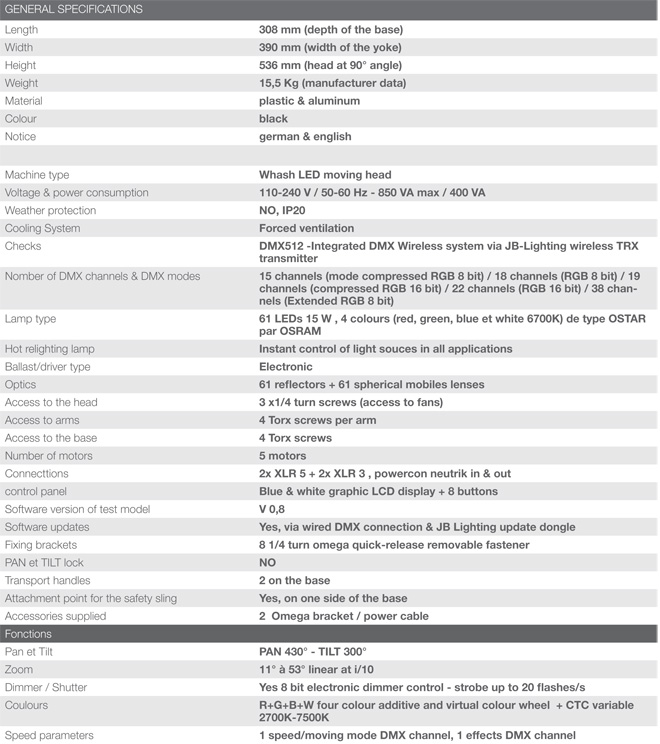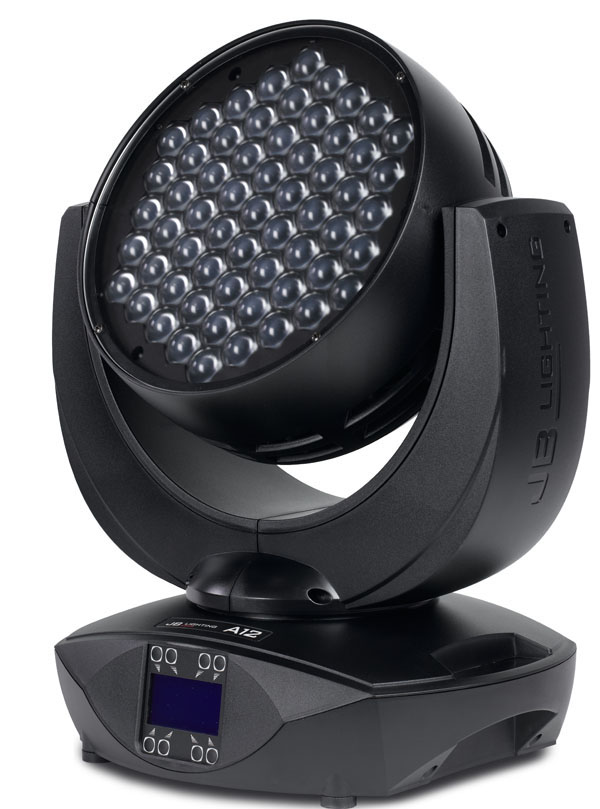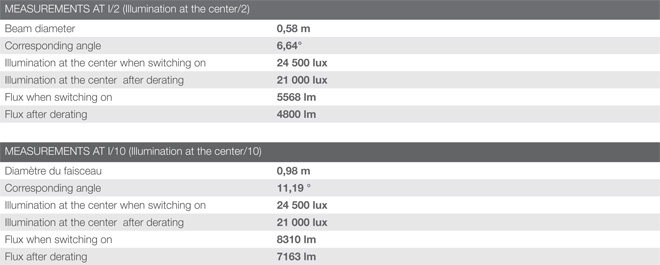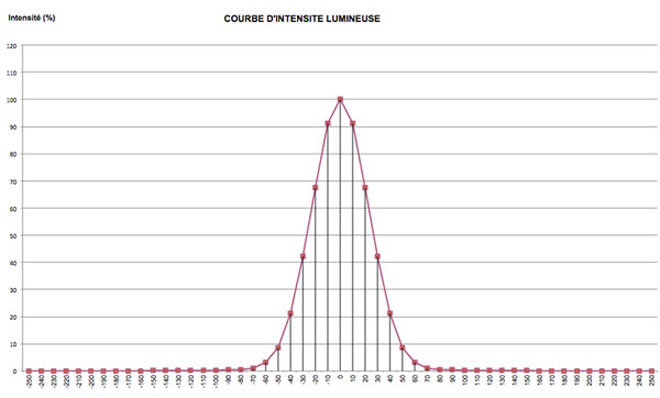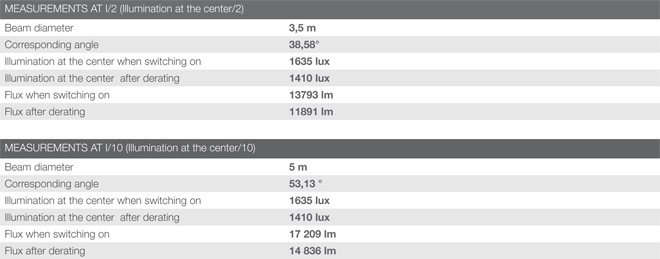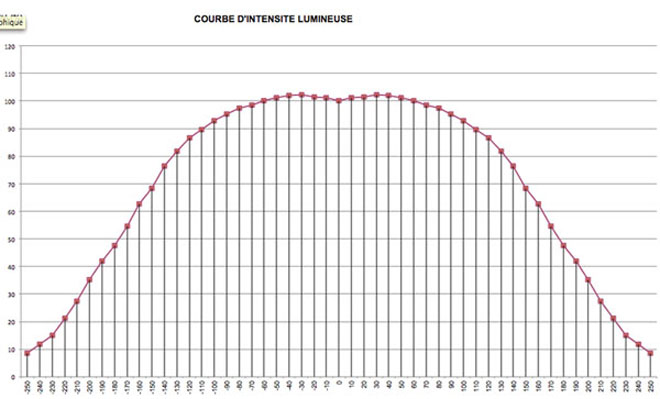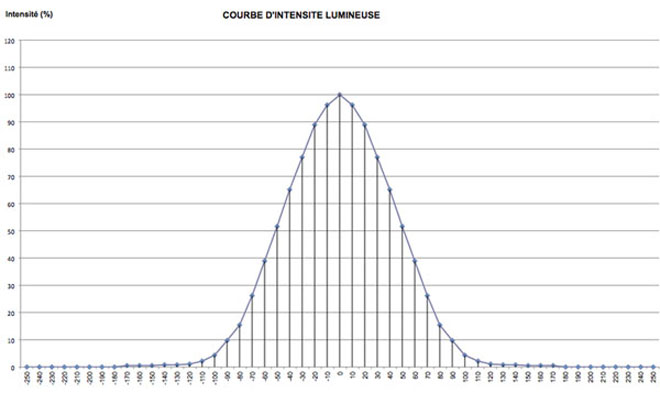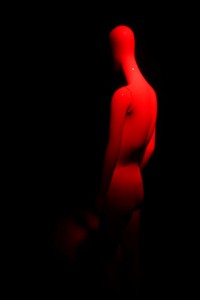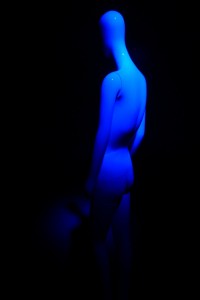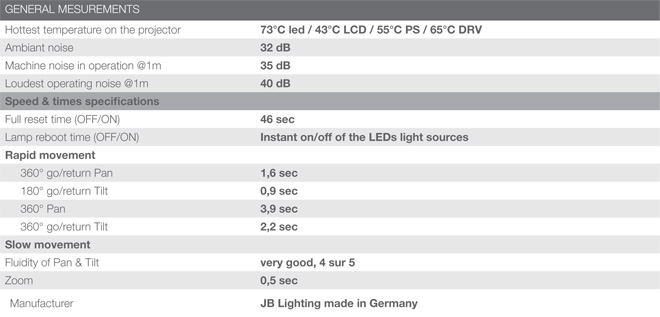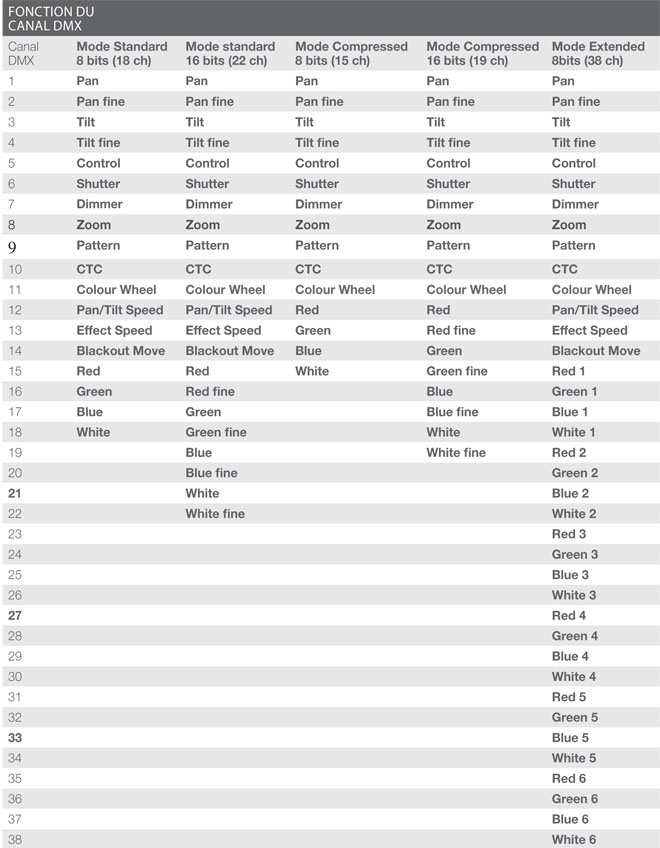This paper is available in Français too
The latest addition to the JB-Lighting range, loaded with 61 15-watt RGBW LEDs, the A12 moving head wash is presented as a technological flagship capable of competing with 1200 W arc-source lights. Beyond the advertising claims, does this unassuming, 100% German mover really revolutionize a market locked into a race for power? When the Parisian rental company NAT didn’t hesitate to invest in a significant number of A12s – 500 units – we decided it was necessary to bring one to the test bench..
Handling and ergonomics
I’m a little naive in my approach to opening the shipping carton. While the older VaryLED zoom and A7 are well established in equipment inventories, JB-Lighting does not necessarily thrill me with their designs. The reported power of the new A12 Wash is spectacular but, unpacking it, I remain skeptical. The unit is compact and all black, very stark in its garb of textured, matte plastic. A few scarce markings recall the brand, two large yoke arms form an arc to support the head, over all no sharp edges: this mover will remain very discreet in lighting kits, as long as it is turned off…
But, here, I gladly confuse “simple” and “easy”: I discovered many very efficient and ergonomic details.
For example, the base is simple. It has an arched top, it is relatively small but stable, with slightly rounded edges and it is extruded on each side to form two solid and comfortable handles. The handling tests must have been carried out by lumberjacks, because you’ll have no trouble with it slipping in your hands. This machine is light, well balanced and easy to handle, even without locking tilt or pan. The thick, arching arms, with “JB Lighting” moulded into them, seem a little disproportionate to the size of the head, but allow for extra holds without damaging the yoke. The unit can be lifted with one (strong) hand. In short, it can be installed without problems.
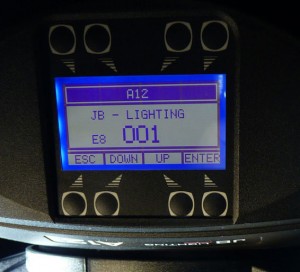
The front offers a simple, blue display, surrounded by JB-Lighting’s famous eight buttons, a row of four below the screen and four others above. Why so many buttons? It’s simple: if A12 is placed on its base, the four buttons at the bottom – “escape”, “+”, “-” and “enter” – manage the navigation menus. The top four are then not used. If you hang the machine upside down, the display is upside down, and the previously unused buttons at the top will be at the bottom. Simply pressing one of them, you automatically invert the display, and the four primary functions will be assigned to these four buttons. It is very convenient. One strike against the unit is that JB Lighting has not incorporated a battery for addressing the unit without power. This is somewhat unfortunate, though not a severe problem.
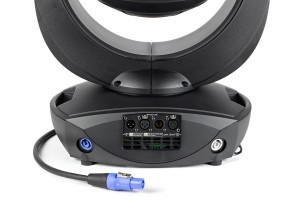
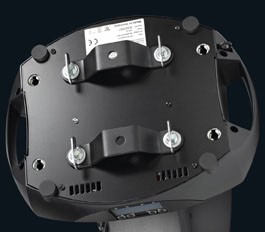
On the rear, the 3-pin and 5-pin DMX connectors are easily accessible (that is to say that they can be disconnected without breaking your fingers). Here, as well, are the Powercon mains connector (blue) and an increasingly rare mains-through Powercon (white) on the other side. The unit consumes about 1000 W at maximum output. Only the most adventurous users would cascade more than three units, but you can do what you like. On the left side of the base is the lug for the safety cable, which is simple but accessible at all times. Additionally, this avoids having a wobbly unit on the ground when the cable twists and refuses to come away from an inaccessible location beneath the base, except for when it flies in your face.
Also for convenience, the eight 1/4-turn, threaded sockets for omega brackets under the base are arranged symmetrically, ensuring at least five ways to install a pair of brackets. This arrangement will be appreciated when the unit is rigged on trusses. Four large rubber feet make it stable when deployed on the floor.
L’optique
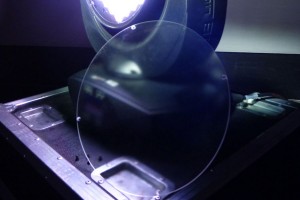
The optical system is nestled in a hemisphere notched with thin air vents on the rear and around the periphery. At the front, under a frosted plexiglass plate – which serves also to protect the optics from dust – 61 thick convex lenses are integrated in a rigid plastic honeycomb, forming an impressive hexagon. Removing this crown of lenses, we find the 61 RGBW LEDs nestled at the bottom of each pyramidal reflector. The orientation of each of these square plates of LEDs is varied one from the other by a few degrees in order to facilitate the mixing of the output beams. The vertical movement of this ring of lenses is driven by three motors arranged at 120°, which will zoom the beam with remarkable speed. The downside of this is that the yield and quality of the color mixing suffer a bit. And it is discovered that the frosted plexiglass plate at the output homogenizes the flux of the wash much like a Fresnel lens, contributing greatly to the color consistency, especially in a tight beam. It seems a little fragile for a key element of the optics, so the user will have to be careful.
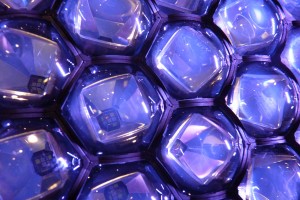
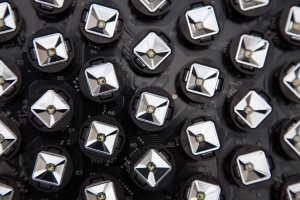
Cooling and LED replacement

Armed with a little patience and a few tools, I now set to dismantling the head. The rear section houses two fans. Removing them, I understand the genius of JB Lighting regarding the interchangeability and cooling of the LEDs. The circuit, flip side, is in contact with a base of aluminum acting as support for 61 heatsinks, each made up of 37 aluminum rods that form an astounding, high-tech forest. Each heatsink is extracted with ¼ turn and we discover, attached underneath, a flexible circuit board, on which an RGBW multichip is soldered. In case of the failure of an LED, this enables the easy replacement of this radiator/circuit assembly, but this is a delicate operation that should be performed either by an authorized service center of the brand or by a technician trained by JB-Lighting.
On the cooling side, each heatsink is encased in a tube that serves as a nozzle, which channels the air pushed by the two fans. Thanks to this novel method, this machine offers a “kolossal” output, while remaining compact and lightweight.
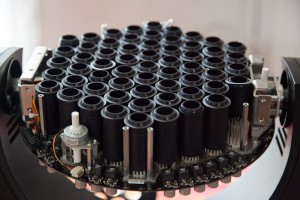
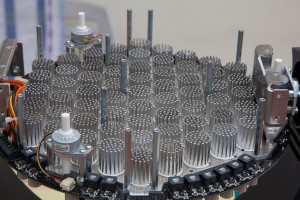
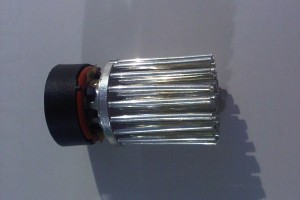
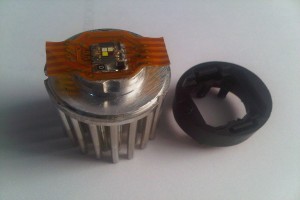
Menu and Service
First, let’s take a short tour through the menu. It is simple and allows access to the main functions without frills.
First of all are the parameter reset and fixture settings (unfortunately not configurable from the console, complicating the maintenance of a large stock of fixtures).
Then, there is the DMX address (obviously). In the customization section it is possible to select between five DMX modes (15 to 38 channels), to reverse pan and tilt and to choose the dimmer curves (“Square” mode has the closest feel to a traditional fader and is also the most accurate at low levels).
L’activation du DMW activation via Wi-fi is enabled by selecting the Wireless DMX mode. I did not test it; it works with the proprietary Wi-fi protocol of the JB-Lighting TRX transmitter.
A special option called “Shortest distance” emulates the operation of a color wheel on the color macro setting. Obviously, the pre-programmed colors go from one to another without scrolling through the whole gamut.
Camera mode lets you choose the most suitable driver frequency to avoid flickering when the fixture is used with video cameras.
Enabling or disabling the forced ventilation: in Silent Mode, the ventilation will stop if you do not push the power of the LEDs. The fans are triggered automatically for safety if the detected temperature requires them (along with the noise that comes with them, but this is reasonable).
You can choose to maintain the last DMX command or to move smoothly to blackout in the event of DMW Wi-fi loss.
Service mode allows you to perform a reset of the machine, list the possible operational failures, to run tests or check the DMX info. You can also calibrate the pan and tilt and, when your stock of A12s begins to age – as happens with LED sources – leading to differences between the units’ color matching (Binning), you can calibrate the different LEDs to correct this. This is done by performing a white balance with each LED color. In this menu you can also perform the software update and here you will find the software version information, the total operation time and temperature information for key components.
For the purposes of our test, I set the A12 on its most comprehensive Mode (extended 8-bit RGB), that is to say, with independent control of six separate LED zones on the head, the dimmer in square mode, normal cooling and pan/tilt modes and without re-calibrating the LEDs.
The unit starts up rather quickly. With a reset on startup of 46 seconds, it is within a good median.
Tests and measurements
After spending a few seconds creating the library (OK, minutes), I take the beast in hand and the least I can say is that, when it is turned on, it assumes its full size.
The luminous output is truly powerful, with 24,500 lux at 5 meters in a tight beam at startup, with all RGBW LEDs lit at full power. The nearly 1000 W of LEDs are clearly not there for decoration.
We wait for the flux to stabilize, measuring the illumination at the center every 5 minutes. After 25 minutes, the decay is 14%. Then we begin our measurements at every ten centimeters on two axes.
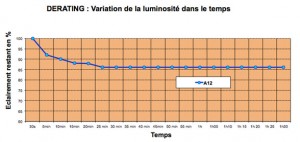
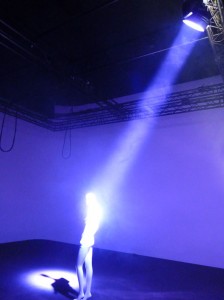
Narrow beam
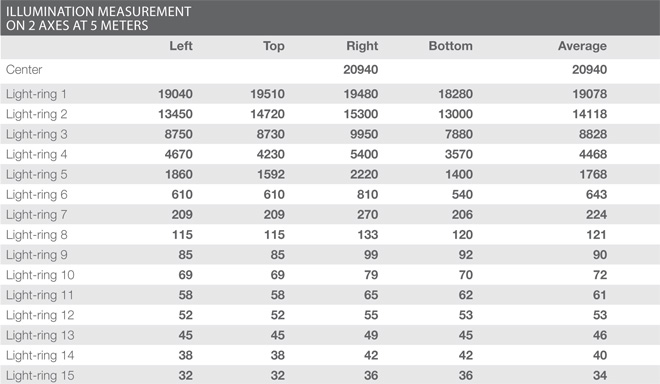
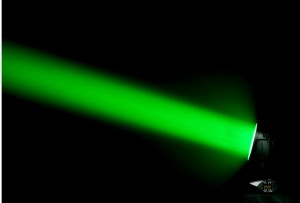
We obtain a very tight beam of 6.64° at I/2 or 11° at I/10 (calculated by finding the border diameter where the beam is at half of the illumination value at the center and at one-tenth of this value and then deriving these projection angles). It has a very high impact in the center of the beam. The mixture of LEDs with red, green, blue and white (all at maximum power) has a slight comb effect right at the output of the optics, visible close to the tight beam.
The point of impact in RGBW also has some slight nuances of color, indicating that JB-Lighting really sought to emphasize the power. The high flux LEDs, along with a good choice of basic colors, can achieve very impressive “beam” effects. This tight beam, together with very quick movements (approximately 1.6 seconds for a 360° rotation in pan and a complete traverse of the tilt range in less than a second), and a wide range of tilt movement make it a thoroughbred racer for concerts, and make us forget about the halo when the zoom is at its tightest.
Wide beam
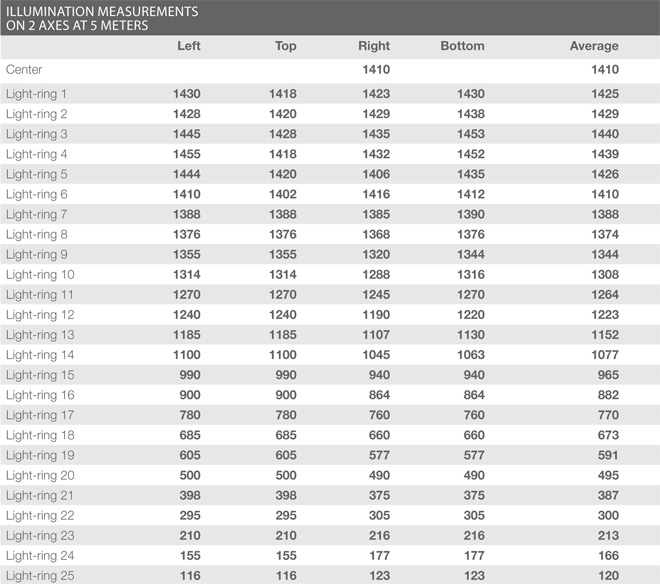
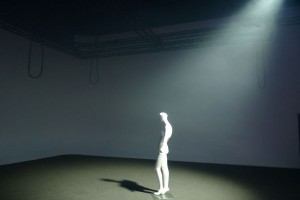
The rapid and wide-ranged zoom assures me of the usability of this wash. It takes barely half a second to go from minimum to maximum – a ratio of one to five. This commands respect. I measured the wide zoom at 53° I/10 and the luminous flux is very impressive: 14,800 lumens after derating. The fixture is obviously optimized for wide zoom, which seems normal for a wash. However, the beam is marked in the center by a “hole” of 5%, and the “edges” are irregular. Some of the shadows obtained tend slightly towards green or red. In addition, when you enlarge the zoom, the beam gives the impression of opening in rings.
20° beam
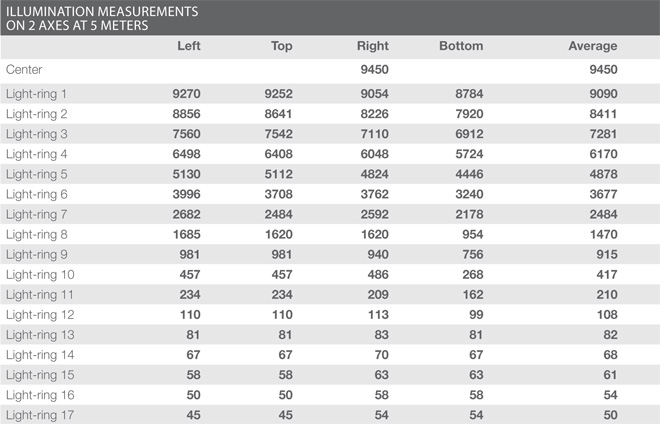
Our measurement for an angle of 20° made for comparison, at 5 meters distance (or a beam of 180 cm diameter) gives a luminance of 9500 lux at the center, for a total flux of 10,700 lumens. Even if it lacks a bit of power for this mover to compete at full strength white with a wash using a 1200 W discharge lamp, on the bolder colors, and even more so on the primary colors, the result is there without a doubt. It soundly beats any HMI 1200, with its weight and responsiveness reduced by half.
Impressions and performance
For a manufacturer, the selection of LEDs depends not only on their power but also on their base colors, which determine a color space more or less suitable for stage use, with deep and saturated colors, or for a more “artistic” use where pastel and very soft hues are sought.
The white LEDs are rated at 7000 K, which is the norm for HMI lamps. They do not, however, seem too cold. Hence the whites of the A12 remain “neutral” in most configurations, powerful without being dazzling. The white LEDs alone emit 45% of the luminous output.
Colours
The reds are bright, strong and can come close to the famous Lee Filter 106 with approximately 18% of the total yield of the LEDs.
The greens, very vivid and almost electric, are very bright with 39% of the luminous output. The color is almost a Lee 139 Filter.
Finally the blues, very dense and saturated with UV, manage to be deeper than Tokyo Blue (Lee 071).
Secondary mixtures provide a brilliant magenta and scarlet. The yellow suffers from a predominance of green and, with pale rendering, it is not very bold. The cyans are brilliant. Beautiful hues between purple, violet and aquamarine are easily obtained. Oranges and pastels are less easy to work with. Blues and reds are very saturated, permitting interesting Congos to be created.
Response curves of dimmer
When the “square” curve is selected the dimmer is very accurate, even at low levels, without a stepping effect when the fader goes below 5%.The A12 also demonstrates great responsiveness in strobing and allows, via the Shutter channel, a full range of strobes – constant, random, pulse and ramping up to 20 Hz – without, however, permitting slowly pulsated strobes. Also noteworthy is a very interesting effect called “fade-effect with dimmer” that simulates the dimming of the LEDs in the manner of a halogen lamp.
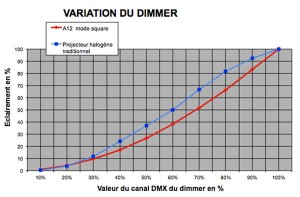
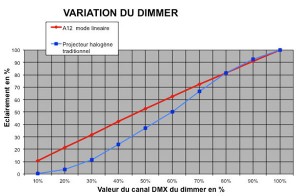
Movements
The movements are precise and fluid when slow and, at the same time, very responsive to rapid changes. Pan movement is limited to 430°, only 1-1/5 turns.
In normal operation, the A12 remains stable, very jumpy, and so easy to program a programmer will have no trouble in mastering dozens on a console.
Special Features
The control parameters allow the reset of the unit and the remote change of some internal parameters, such as the driver frequency to avoid flickering in video or the setting of the white balance at 8500 K or 6500 K. A special feature (color balance for color picker) calibrates the colors to 6500 K, while smoothing linear RGB curves. This mode allows you to obtain pastel shades more easily, but denaturalizes the bold colors.
In addition to red, green, blue and white, the A12 provides an (electronic) warm corrector setting, acting on RGB mixes only. It is rather crude. It works fairly well to the eye but not to the camera, varying the colors too much. Do not count on it for refined, beautiful skin tones or halogen tones, those remain difficult to obtain.
The color macro setting overrides the RGB mixing when it is activated, providing 17 basic colors and scrolling “rainbow” type effects. You can not make smooth transitions between RGB color mixing of the LEDs and a particular color among the macros, but this setting has two functions that are very well thought out. First of all, a feature allows you to assign the setting of the first ring of LEDs to the entire array. If you recall, for my initial settings I used the extended mode; that is, with the possibility to control separately the groups of LEDs of the fixture.
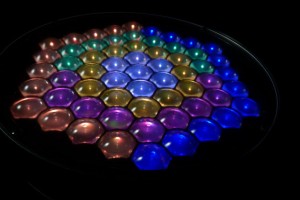
In routine use, a single color is most often used, thus forcing me to program the six groups of LEDs to the same RGB setting – a somewhat tedious process. If I activate the “inner ring” function, however, I just have to worry about the color of the first ring, and all other LEDs follow this setting automatically.
The second good idea is the use of the color macros as a supplement to the RGB settings to generate a large number of effects between the different groups of LEDs via the “Pattern” parameter.
This “pattern” parameter offers seven preset chase effects between the different LED rings. Oddly, at JB Lighting they chose a compromise in determining LED rings to be usable individually. With other manufacturers, distribution of the LEDs was done in half or quarter sections, like pie slices, before opting for concentric circles and, eventually, point by point in the most advanced fixtures. In this one, we can control the center, the first ring all together, then the top and bottom half rings of the second and finally the left and right half-rings of the outer ring. Personally, even if it had meant multiplying the groups of LEDs, I would have preferred the outer ring separated into four sections for richer dynamics and to allow me to carve out a little in the beam’s projection.
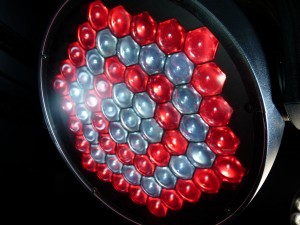
This is even more unfortunate because the management of effects (or patterns to use a more appropriate word) is very nice. On the same DMX channel, you can select an effect with different possible speeds, with or without a fade, and you get a “chaser” of LEDs, such as fills, back and forth or randomly between two colors. These are determined by the programmed color of the LEDs in the center in RGBW, on the one hand, and through the macro channel on the other.
The rest of the functions are very simple, with a speed control for the movement and effects, a “blackout” function that cuts the dimmer when changing position or color (which I absolutely never use, except to play a prank on the console operator), then the control parameters for the red, green, blue and white LEDs, depending on the mode selected.
Despite a very tight schedule, I can not resist the temptation to have a little fun with our test unit and I make it do tricks and loops incessantly. It does not give out and continues to impress me with its movements.
Verdict
I really feel that the design is based principally on ergonomics. Lightweight, well-balanced, reliable, easy to handle and fix, and very quick to deploy, this optimized wide-beam wash proves to be an excellent unit for touring, festivals or event stages. It will also be quite at home as a wash for large exhibition areas or large meetings. Its power, choice of colors, the speed of its movements and highly reactive 5X zoom tailor it for aggressive and spectacular use. The design of its LEDs and its rather reduced capacity for matrixing, however, may not be suitable for everyone for close-up use, and the halo of light around the tight beam somewhat complicates its integration into a scene. But the overall quality of light is very correct, and its phenomenal power more than compensates its uniformity, which leaves room for improvement.
